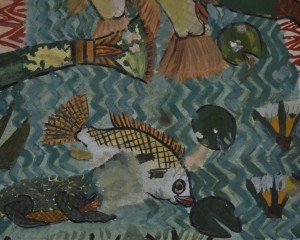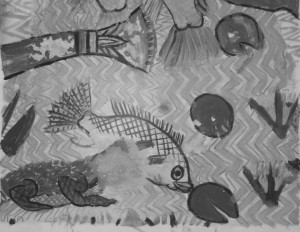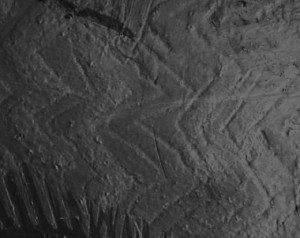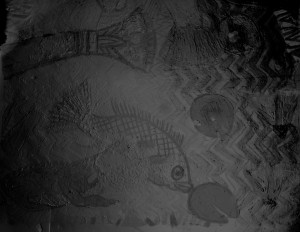Infrared RTI: Experimentation towards the development of multispectral RTI
Multispectral Imaging and Reflectance Transformation Imaging (RTI) are both useful imaging tools for the examination of antiquities and works of art. Previous research proved that RTI contributes significantly in prevention, investigation, examination, analysis and documentation, communication, dissemination and presentation of antiquities and works of art. Multispectral Imaging provides valuable information for authentication and artefacts studies as well as for conservation operations, as it reveals features invisible with the naked eye. Multispectral RTI can potentially enhance multispectral photographic examination, offering the possibility to visualize not solely the hidden inner or outer layers, but also its three-dimensional reflectance properties, enabling advanced examination, as well as assisting interpretation. Our recent work focuses on the infrared spectral region and discusses our first experimental results towards the development of a multispectral RTI methodology for examination, characterization, recording and documentation of antiquities and works of art.
Multispectral Imaging
Infrared reflected and transmitted imaging provides information about layering of painted artefacts and works of art, epigraphy on textile, wood, stone, metals, and ceramics. It penetrates aged and/or oxidised varnishes and colour layers. It reveals stages of creation of an artefact, details hidden beneath coloured varnishes or degradation effects, such as encrustations. It is extremely helpful for the detection of “pentimenti”, under-drawings and over-paintings (older or modern). Multispectral Imaging has been used to document and improve the reading of ancient inscriptions, as well as to identify and differentiate materials, in papyrus (Alexopoulou et al. 2012), pottery (Faigenbaum et al. 2012), scrolls (Knox et al. 1997) and palimpsests (Easton, Jr. et al. 2003; Maino 2007; Balas et al. 2003)
Near infrared bands are useful for painted artefacts, and particularly for damage assessment and for revealing the under-drawings (preparatory sketch), for authentication purposes, as well as in art history studies (Liang 2012). Fischer and Kakoulli emphasize the characterization and mapping of pigments and inks as well as the study and differentiation of organic binding media in case of multispectral imaging of painted artefacts and drawings (Fischer & Kakoulli n.d.). Worth mentioning is that spectral imaging has been used in order to capture and visualize features which are invisible to the naked eye, such as the detection of damages and past intervention and retouches. Also, it can provide a valuable tool in the assessment of conservation treatments. Alterations introduced during conservation operations or damages can be determined and visualised, providing a better understanding of the material ageing phenomena as well as for the processes used in order to pace their rate. Examples on marbles, paper, parchment and wall paintings demonstrate the efficiency of multispectral imaging in providing answers to these questions and in that way assisting remedial conservation (Liang 2012).
RTI
Reflectance Transformation Imaging (RTI) (Mudge et al. 2005) and one of its subdivisions, Polynomial Texture Mapping (PTM), developed in 2001 at Hewlett Packard Laboratories (Malzbender et al. 2001), is a non-destructive, affordable and easy imaging technique, useful for conservators, archaeologists, curators and finds specialists. Via RTI, experts and the public can experience views of the artefacts in a new way that is superior to visual examination or handling with the naked eye or even under a microscope lens. Previous work has already proved that RTI significantly contributes to analysis, conservation and representation (Graeme Earl et al. 2010). There are many interesting applications in the field of cultural heritage, based on its ability to acquire and represent the 3D reflectance properties of objects. Related projects are the Antikythera Mechanism (Malzbender 2007), the RTISAD Project of the University of Southampton and the University of Oxford (Earl, G. et al. 2011), Reflectance Transformation Imaging in Canada at Queen’s University (RTIiCAN) (Gabov & Bevan 2011), and Reflectance Transformation Imaging (RTI) in art conservation, a collaboration between the Fine Arts Museums of San Francisco and Cultural Heritage Imaging (CHI). Previous work includes the application of RTI in paintings, scrolls, wood, metals, ethnographic materials, sculpture etc (Caine & Magen 2011; Padfield et al. 2005; Karsten & Earl, G. 2011). Microscopic RTI, using the highlight or the dome method, gave interesting results and this lead to its broader application in the cultural heritage sector, particularly in conservation practice (Kotoula, E. & Earl, G. 2012).
Multispectral RTI
Although the potential of a synergy of RTI and multispectral imaging has been discussed (Schroer & Mudge 2012; Castriota & Serotta 2011) there is only fragmented and limited information (Gabov 2010) rather than concise and focused research on the field. Questions arise whether a synergy of multispectral imaging, in particular infrared imaging, and RTI (multispectral RTI), can lead to an improved methodological approach for examination of antiquities and works of art. A key element of our experimental approach is the investigation and understanding of RTI in wavelengths other than the visible, which will lead to the evaluation and development of a multispectral RTI methodology for examination, characterization, recording and documentation of antiquities and works of art, covering a wide range of material types. A critical issue is the unevenness in illumination, which can appear as different absorbency.
We performed the experimental captures with a UV-VIS-IR modified Nikon 700 digital slr camera along with a filter that blocks visible and transmits infrared above 720 nm. The RTI data capture methodology is either the highlight or the dome method. The data processing is identical to that in visible light, apart from basic processing of IR images.
For the purposes of the present post, a replica from a wall painting decoration scene of the Tomb of Menna in Egypt was the trial artefact for the first experimental RTI capture in the infrared spectral region. The visible RTI emphasizes the texture and reveals brush strokes and minor anomalies on the surface. Even the finest details, such as the thin colour layer become apparent (figure1).


The reflected infrared image provides information about the layering of the painted artefact and reveals details hidden beneath colour. The low-IR-intensity used penetrates thin outer colour layers and reveals a number of lines, originally parts of the preparatory sketch. These features disappear in the reflected infrared RTI, which reveals not only the hidden inner layer, but also its texture.

This example demonstrates that multispectral imaging, in synergy with RTI, offers the possibility to visualize three-dimensional reflectance properties of artefacts, even in case of hidden and obscured details. Our ongoing project will continue experimentation, covering a variety of material types in addition to higher infrared intensities, in order to fully understand the interaction between multispectral imaging, RTI, and artefacts examination. Moreover, the ultraviolet spectral regions will be taken under consideration. Hence, the most appropriate methodology for multispectral RTI can be proposed.
The multispectral RTI capture of painted ceramics and documentary artefacts (papyrus) from the Derveni Cemetery in Macedonia, Greece, currently located in the Archaeological Museum of Thessaloniki, is planned, as part of this ongoing project.
References
Alexopoulou, A.A. et al., 2012. Multispectral documentation and image processing analysis of the papyrus of tomb II at Daphne, Greece. Journal of Archaeological Science, (0). Available at: http://www.sciencedirect.com/science/article/pii/S0305440312004153.
Balas, C. et al., 2003. A novel hyper-spectral imaging apparatus for the non-destructive analysis of objects of artistic and historic value. Journal of Cultural Heritage, 4, pp.330-337.
Caine, M. & Magen, M., 2011. Pixels and Parchment: The Application of RTI and Infrared Imaging to the Dead Sea Scrolls. In EVA London. Available at: http://www.eva-london.org/past-eva-londons/2011.
Castriota, B. & Serotta, A., 2011. Reflectance Transformation Imaging Training at the Conservation Center. Newsgram: News in brief from the Conservation Center, (4), pp.1-2.
Earl, Graeme, Martinez, K. & Malzbender, T., 2010. Archaeological applications of polynomial texture mapping : analysis , conservation and representation. Journal of Archaeological Science, pp.1-11. Available at: http://dx.doi.org/10.1016/j.jas.2010.03.009.
Earl, Graeme. et al., 2011. Reflectance Transformation Imaging Systems for Ancient Documentary Artefacts. EVA London: BCS. In EVA London.
Easton, Jr., R.L., Knox, K.T. & Christens-Barry, W.A., 2003. Multispectral imaging of the Archimedes palimpsest. In Applied Imagery Pattern Recognition Workshop, 2003. Proceedings. 32nd. pp. 111-116.
Faigenbaum, S. et al., 2012. Multispectral images of ostraca: acquisition and analysis. Journal of Archaeological Science, 39(12), pp.3581-3590. Available at: http://www.sciencedirect.com/science/article/pii/S030544031200252X.
Fischer, C. & Kakoulli, I., Multispectral and hyperspectral imaging technologies in conservation : current research and potential applications.
Gabov, A., 2010. IRR RTI using the Osiris, RTIiCAN’s Blog – Research, Art Conservation & Archeology. Available at: http://rtiican.wordpress.com/2010/01/10/irr-rti-using-osiris/.
Gabov, A. & Bevan, G., 2011. RTIiCAN blog. Available at: http://rtiican.wordpress.com.
Karsten, A. & Earl, Graeme, 2011. Stirling Castle Wood Recording Project: Polynomial Texture Mapping and Laser Scanning for the analysis of pre- and post-conservation wooden artefacts.,
Knox, K.T., Johnston, R. & Easton Jr., R.L., 1997. Imaging the Dead sea scrolls. Optics & Photonics News, 8(8), pp.30-34.
Kotoula, E. & Earl, Graeme, 2012. RTI and Conservation Practice. In Imaging in Conservation: Looking at artefacts under new light. ICON Archaeology and Science Group, in press.
Liang, H., 2012. Advances in multispectral and hyperspectral imaging for archaeology and art conservation. Applied Physics, pp.309-323.
Maino, G., 2007. Digitization and multispectral analysis of historical books and archival documents : Two exemplary cases. Processing, (Iciapw).
Malzbender, T., 2007. Relighting the Antikythera Mechanism Tom Malzbender Laboratories. Image Rochester, N.Y.
Malzbender, T., Gelb, D. & Wolters, H., 2001. Polynomial texture maps. In Proceedings of the 28th annual conference on Computer graphics and interactive techniques. New York, USA: ACM Press, pp. 519-528. Available at: http://dl.acm.org/citation.cfm?id=383320&dl=ACM&coll=DL&CFID=91528132&CFTOKEN=72630427.
Mudge, M. et al., 2005. Reflection Transformation Imaging and Virtual Representations of Coins from the Hospice of the Grand St . Bernard. In M. Mudge, N. Ryan, & R. Scopigno, eds. VAST05: The 6th International Symposium on Virtual Reality, Archaeology and Intelligent Cultural Heritage. Pisa, Italy: Eurographics Association, pp. 29-39.
Padfield, J., Saunders, D. & Malzbender, T., 2005. Polynomial Texture Mapping: A New Tool for Examining the Surface of Paintings. In ICOM Committee for Conservation Triennial Meeting. Eurographics Association, p. 504–510.
Schroer, C. & Mudge, M., 2012. Advances in the computational photography tools: Reflectance Transformation Imaging (RTI) and Algorithmic Rendering (AR). Computer Applications and Quantitative Methods in Archaeology-CAA 2012. Available at: https://www.ocs.soton.ac.uk/index.php/CAA/2012/paper/view/633.


